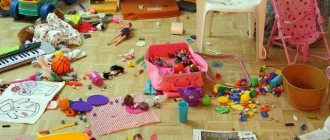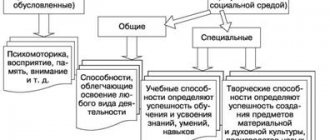Hello, readers of my blog!
The ability to be creative is something that has been valued by people for many centuries. Creative people contributed to the development of new inventions, medicines, and discoveries in science. Such people are a kind of generator of ideas that moves humanity forward.
The development of creative activity is not as simple as it might seem at first glance. Today we will look at this issue from all sides. So, let's figure out why you need to develop creative abilities.
Manifestation
Psychology defines ability as the sum of psychological and physical qualities that influence the choice of human activity.
There are general abilities that are required in most professions. These include attentiveness, intelligence, speech.
But there are other abilities that make a person stand out from the crowd. This is a keen ear for a musician, a creative vision and a sense of color for an artist.
Types of abilities
There are different classifications of abilities.
By origin
distinguish natural and specifically human abilities:
1) natural (natural) abilities
– these are biologically determined abilities associated with innate inclinations, formed on their basis through learning mechanisms such as conditioned reflex connections;
2) specifically human abilities
– these are abilities that have a socio-historical origin and ensure the life and development of a person in a social environment.
Specific human abilities
, in turn, are divided into
are common
and
special higher intellectual abilities,
theoretical
and
practical
,
educational
and
creative
,
subject
and
interpersonal
.
General Abilities
– abilities that determine a person’s success in a wide variety of activities and communication (mental abilities, developed memory and speech, accuracy of hand movements, etc.).
Special Abilities
– abilities that determine a person’s success in certain types of activities and communication. For their emergence, special inclinations and special development are required (mathematical, technical, literary and linguistic, artistic and creative abilities, sports, etc.).
General and special abilities can complement and enrich each other, but each of them has its own structure.
Theoretical abilities
– a person’s ability for abstract logical thinking and theoretical intellectual work.
Practical
abilities
are a person’s abilities for specific practical actions, for practical types of work.
If general and special abilities can complement each other, then theoretical and practical abilities are combined only among multi-talented people; in most cases, one type of ability (theoretical or practical) predominates.
Learning
abilities
are abilities that influence the success of pedagogical influence, a person’s assimilation of knowledge, skills, and abilities, and the formation of personality traits.
Creative skills
– abilities associated with the success of creating works of material and spiritual culture, new ideas, discoveries, inventions.
Interpersonal
abilities
are the ability to communicate, to interact with people through speech, the ability to perceive and evaluate people, the ability to socially and psychologically adapt.
Subject Abilities
– abilities related to the interaction of people with nature, technology, symbolic information, and artistic images.
Further:
3. Origin and development
Up:
Topic 4. Abilities
Back:
1. Concept and characteristics
of YSPU, Department of Educational Information Technologies 07.26.2010
Development
The process of developing creative abilities begins in childhood.
The main source of talent, of course, is the innate ability in children.
However, without training, the talent can dissolve, as if it never existed.
In preschoolers, the development of creative skills is much easier and faster. A child absorbs new knowledge like a sponge.
For example, in classes with preschool children, the creative potential of each child is revealed.
Children, as you know, are not withdrawn into themselves and are not influenced from outside, like adults. Such openness and attraction to new knowledge helps them absorb information several times faster.
A good teacher who works with children has a plan for developing creative thinking and skills that children master as they learn.
It's incredibly important to unleash your creativity at an early age. It is then that the foundations of personality are laid.
A child’s creative abilities will help the child both in school and in life.
Scientists have proven that people with creative thinking have greater communication skills and work activity; they are able to solve non-standard problems and introduce creative ideas into the work process.
However, if you are an adult, this does not mean that you should forget about creativity. Many people want to realize themselves in creativity because this is what they wanted in childhood. But due to circumstances, they chose a different path in life. And they succeed. The main thing here is to have a desire and a good teacher.
Personal communication abilities
It should be emphasized that an important factor in a person’s success is his ability to establish contact with others. That is, we are talking about an individual’s ability to communicate, the degree of development of which will subsequently play a role not only in professional or social, but also in any other area of an individual’s life.
As in any other case, the development of communication abilities begins in early childhood. The sooner a child learns to speak and express his thoughts, the easier it will be for him in the future to establish contact with his peers and other people around him. And this means.
That such a child will gain as much experience in communication as possible. Of course, everything also depends on how the experience turns out. In other words, communication abilities depend on the factor of relationships with others, which are formed throughout life. At an early age, such a factor becomes parents and relationships with them, later - peers, and even later - friends or colleagues.
If from an early age a child does not receive proper support from family and loved ones, he very quickly becomes withdrawn, unsure of himself, trying to bypass the need to communicate with anyone in any way. Consequently, the ability to communicate and create any kind of social connections for such an individual will pose an impossible problem. The solution to this problem can only be a repeated process of developing communication skills. What can either specialists – psychologists, or loved ones – help with?
Creativity for adults
You can develop your creativity in different ways. Let's look at the example of drawing, what is important in self-realization.
Three things are important for an adult to realize their creative potential:
- Mindfulness. Are you sure you want to improve your drawing level?
- Practice. You enjoy drawing and regularly complete creative tasks.
- Creativity. You try different techniques, don't stop at one idea, you are in continuous search.
Exercises
The topic of developing creative abilities is gaining increasing relevance these days. Self-education is very popular. People want to learn new things and try themselves in new areas.
The creative abilities of an individual can be trained. How do you know whether a person has developed creative abilities or not? If you are interested in this, here are two exercises:
The “Association Game” exercise is aimed at creative work and generating ideas. Take a piece of paper and write down on it the first word that comes to your mind. It should be an abstract word that you are not attached to. For example, "piano".
Then, once you've chosen a word, remember the first association that comes to mind. There is no need to think long and specially come up with an association. It should be spontaneous and unconscious.
It is important that you come up with each new association for a new word.
Let's trace two chains of associations:
Piano – notes – musician – artist – stage – performance.
Piano – keys – yin and yang – China – porcelain – auction.
- In the first case, the associations are in the same topic. The person failed to go beyond stereotypical thinking.
- In the second case, the associations are in an unconditional connection with each other, but the course of thinking itself changes its direction from one area to a completely different one.
From these examples it is clear that the second chain of associations belongs to a person with more developed creative abilities.
This game is useful for both adults and children to play. An effective method that trains intellectual and creative abilities.
The second exercise, “Universal Subject,” trains creative thinking, imagination, and imaginative thinking.
Name any item that comes to mind first. And then figure out how it can be used other than its intended purpose. The larger the number of words in the resulting chain, the more creative you think.
For example, the word “frying pan”. It can be used as a fan, tray, palette, cap, umbrella, tennis racket...etc.
This game can be played in a group. Anyone who does not come up with a new purpose leaves the circle. This way, the most creative person in the company is identified.
Creative abilities of the individual
Many people mistakenly believe that creative abilities include only drawing, writing and music. However, this is absolutely false. Since the development of an individual’s creative abilities is closely interconnected with the individual’s perception of the world as a whole and his sense of himself in it.
The highest function of the psyche, reflecting reality, is creativity. With the help of such abilities, an image of an object that does not exist at that moment or that never existed at all is developed. At an early age, the foundations of creativity are laid in a child, which can manifest themselves in the formation of the ability to conceive and implement it, in the ability to combine their ideas and knowledge, in the sincerity of conveying feelings. The development of children's creative abilities occurs in the process of various activities, for example, games, drawing, modeling, etc.
The individual characteristics of a subject that determine the individual’s success in performing any creative activity are called creative abilities. They represent a combination of many qualities.
Many famous scientific figures in psychology combine creativity with thinking characteristics. Guilford (an American psychologist) believes that creative individuals are characterized by divergent thinking.
People with divergent thinking, when searching for a solution to a problem, do not focus all their efforts on establishing a single correct answer, but look for various solutions in accordance with all possible directions and consider many options. The basis of creative thinking is divergent thinking. Creative thinking is characterized by speed, flexibility, originality and completeness.
A. Luk identifies several types of creative abilities: finding a problem where others do not notice it; collapsing mental activity, while transforming several concepts into one; using the skills that have been acquired in finding solutions from one problem to another; perception of reality as a whole, and not splitting it into parts; ease of finding associations with distant concepts, as well as the ability to provide the necessary information at a certain moment; choose one of the alternative solutions to the problem before checking it; show flexibility of thinking; introduce new information into an existing knowledge system; see things and objects as they really are; highlight what is noticed from what the interpretation offers; creative imagination; easy to generate ideas; refining specific details to optimize and improve the original idea.
Sinelnikov and Kudryavtsev identified two universal creative abilities that developed in the process of historical development of society: realism of imagination and the ability to see the integrity of a picture before its component parts. Imaginative, objective grasping of some significant, general pattern or tendency for the formation of an integral object, before the individual has a clear idea of it and can introduce it into a system of clear categories of logic, is called realism of the imagination.
The creative abilities of an individual are a set of character traits and properties that characterize the level of their compliance with certain requirements of any type of educational and creative activity, which determine the degree of effectiveness of such activity.
Abilities must necessarily find support in natural personality qualities (skills). They are present in the process of constant personal improvement. Creativity alone cannot guarantee creative achievement. To achieve, you need a kind of “engine” that can put mental mechanisms into action. Creative success requires will, desire and motivation. Therefore, eight components of the creative abilities of subjects are distinguished: personality orientation and creative motivational activity; intellectual and logical abilities; intuitive abilities; ideological properties of the psyche, moral qualities that contribute to successful creative and educational activities; aesthetic qualities; communication skills; the individual’s ability to self-manage his educational and creative activities.
Special Skills
The challenges of developing creativity include connecting an idea and a practical solution. In any creative field, simply having an original idea is not enough. It is very important to know how to implement it. This is why people study for many years and acquire mastery.
Young musicians study notes and musical literacy, and then transfer their theoretical knowledge to practice. Bringing these two aspects together takes a long time.
Formation and development of practical skills allows you to realize all the ideas that are in your head.
Are you familiar with the situation when you have a beautiful image formed in your head, which you tried to depict on a piece of paper, but got nothing but disappointment?
This problem arises precisely due to the lack of proper drawing skills. Many people mistakenly think that they are mediocre and lack creativity. However, it is not.
During training, a person acquires the necessary skills that transform him from an amateur into a master. And his work becomes art.
It often happens that the desire and need for drawing is not fulfilled, and a person’s creative potential is not realized. You may have high creative potential, but if you fail to realize it in time, you will say goodbye to creativity and feel empty.
What are the makings of a person?
A person is characterized by the possession of certain inclinations: a distinction is made between congenital and acquired. The development of a person’s abilities takes place in several stages, but only certain abilities reach a high level. To achieve it, you must have a certain initial level. The deposit becomes the basis from which further steps are taken. It also determines individual characteristics during the formation of special abilities. Individual abilities develop through the interaction of hereditary characteristics and the environment, and this manifests itself already at birth. From childhood, a person is ingrained with such properties that with age can help or hinder the formation of specific abilities. At the same time, based on the research conducted, it has been proven that the human nervous system does not predetermine forms of behavior, and inclinations are not formed in it. A person’s nervous system determines his temperament; the choice of activity by each person depends on it.
The conducted research allows us to assert that inclinations are determined by the social environment. Training and upbringing fundamentally influence behavior and psychological state. Studies have been conducted to identify differences in abilities between men and women. In childhood, there was no significant difference in abilities. But with age, when life experience accumulates, when professional activity leaves its mark, the differences become more pronounced. Men who engage in physical labor have more developed coordination of movements, they do not experience difficulties with orientation in space, etc. Women have better developed speech, faster speed of information perception, counting, etc. Thus, the social environment has a direct impact on the formation of abilities , complementing and developing biological ones.
Creativity and Intelligence
An interesting fact is that the most creative people are those with average intelligence. Among people whose IQ is below 100, creativity and creativity are not observed.
Those whose intelligence is over 130 are hampered by logic and rationalism. They do not allow creativity to “grow”.
Thus, we can conclude that high intellectual abilities do not guarantee high creative success.
Along with the IQ coefficient, a creativity coefficient was created - Cr. There are special tests to determine your level of creativity.
Children's activities
Separately, I would like to talk about children's creative activities. Many parents strive to send their children to various sections and clubs. And this is correct, since it is in childhood that special skills are laid and developed.
Drawing is responsible for the development of creative abilities like no other subject.
Nowadays, there are various technologies and means to ensure that learning proceeds with comfort for the child, and knowledge gradually settles into the head.
What skills does the child acquire?
- Concentration. The child focuses on his actions and analyzes the result.
- Intellectual development. The brain receives a lot of new information and connects tactile and visual sensations.
- Color and its nature. When mixing colors, the child learns that he can not only create a new color, but also choose it.
- Fine motor skills. Working with a pencil and brush makes you better with your pens.
- Mindfulness. The child understands that he can create a new image that he chooses himself.
A drawing lesson can often give you more than you expect.
The means for developing children's creative abilities are activities in creative groups or individually.
For preschool children, individual lessons are best. One-on-one contact with the teacher allows the child to better assimilate information.
It is important to give elementary school students interesting and modern tasks so that drawing will open up a completely different side for them.
Lessons to develop children's creativity may also include modeling with plasticine or salt dough. Children love to sculpt and imagine. Salt dough makes very beautiful products, which can then be fired.
Children's creativity
A child has creative abilities when there is a correlation of three features:
- The presence of special abilities: musical, artistic, cognitive, high intelligence;
- High motivation: wants to do something, is interested in the world, willingly explores it and seeks answers to questions that bother him;
- Creative thinking is the ability to search for new ideas. This involves creating situations that originate in the child's rich imagination.
Children's creativity
If parents want their child to strengthen and develop their talents, they should pay attention to preschool age
Important! Preschool age is a period in which various talents appear. Their early recognition and development can bring impressive results and determine the future life of the baby
Their early recognition and development can bring impressive results and determine the future life of the baby
Important! Preschool age is a period in which various talents appear. Their early recognition and development can bring impressive results and determine the future life of the baby
The formation of ingenuity and natural creativity occurs at a young age, up to 5 years. In older children, there is a decrease in creative abilities, which are inhibited when not stimulated.
An intelligent, gifted preschooler may experience a steady decline in his skills as he enters school. Pedagogical mistakes consist in the fact that talented children are considered hyperactive or, conversely, aloof. This is because what interests peers may seem boring to them.
During adolescence, they also face boredom, which can lead to frustration with learning and poorer grades.
Important! The goal of pedagogy is to create conditions for maximum self-expression for such children, setting tasks in the classroom and for activities outside of school hours, taking into account their level
Modern solution
In the modern pace of life, it can be difficult to take children to classes. How much time do we spend on the road every day? Parents are busy at work and at home.
But this does not mean that if you lack time you cannot be creative. Developing children's creative abilities via the Internet is convenient and simple.
There are online courses and schools, as well as fine art tutors who can teach you any technique. Such activities are suitable for both children and adults. Study what you've always wanted in the comfort of your own home - what could be better?
Personally, I have been teaching fine arts since 2014.
I have experience teaching both adults and children. After moving to another country, I continued teaching via Skype. The students are happy and continue to study with pleasure.
To study with me, write to me by mail or on one of the social networks. networks.
The concept of special creative abilities, the specifics of their manifestation in fine art.
Methodological development. The concept of special creative abilities, their specificity
manifestations in fine art.
In relation to visual activity, it is important to highlight the content of the abilities that manifest themselves and are formed in it, their structure, and the conditions of development. Only in this case is it possible to purposefully develop a methodology for developmental teaching of visual arts.
An attempt to determine the content of abilities for visual activity has been made repeatedly by different researchers. In contrast to the content of abilities for other types of activities, the content and structure of these abilities are to a certain extent revealed and presented in psychological and pedagogical literature. However, they are not indisputable simply because they are different either in their essence, or in volume, or in structure.
The available data on this problem can be analyzed based on the approach generally accepted in the theory of abilities to determine their content - based on the specifics of the activity.
Visual activity is a reflection of the environment in the form of specific, sensually perceived visual images. The created image (in particular, a drawing) can perform different functions (cognitive, aesthetic), since it is created for different purposes. The purpose of the drawing necessarily influences the nature of its execution.
The combination of two functions in an artistic image - image and expression - gives the activity an artistic and creative character, determines the specifics of the indicative and executive actions of the activity. Consequently, it also determines the specifics of abilities for this type of activity.
The process of creating an image consists of two parts: the formation of a visual representation and its reproduction (G.V. Labunskaya, N.P. Sakkulina).
The first part of the activity is called indicative, and the second – executive (L.A. Wenger, N.P. Sakkulina). Different in nature, they require a person to demonstrate different qualities (properties) of the individual, i.e. abilities.
Let's consider how researchers take into account the features of visual activity when highlighting the content and structure of this type of ability.
IN AND. Kireenko considers the ability for visual activity as certain properties of visual perception, namely:
- the ability to perceive an object in the combination of all its properties as a stable systemic whole, even if some parts of this whole cannot be observed at the moment;
- the ability to evaluate deviations from vertical and horizontal directions in a drawing;
- ability to evaluate proportions;
- the ability to assess the degree of approximation of a given color to white;
— ability to evaluate prospective reductions.
A whole series of experiments conducted by V.I. Kireenko, is aimed at identifying qualitative differences in these aspects of visual perception among schoolchildren and students of secondary art schools, teachers with special art education, as well as adults and non-drawing children. These experiments provide interesting answers to questions about the quantitative and qualitative features of visual perception in those who draw and those who do not, in adults and children, that is, answers to questions about the degree of expression of the ability for visual activity, depending on a number of factors.
However, the selected abilities only allow one to form a more or less accurate idea of the depicted object and do not make it possible to depict it. Moreover, abilities of this kind do not allow one to create an expressive creative image.
Thus, the author has identified, although important, but far from exhausting the specifics of activity, a group of abilities.
A unique approach to highlighting the content of abilities in visual activity is suggested by A.G. Kovalev. He is not talking about abilities, but about the ability to perform activity, which has its own structure. It has a first component – a leading property and two supporting ones. He identifies the structure of ability based on the predominant manifestation in activity of certain mental properties: the leading property is artistic imagination, without which the development and implementation of a plan is impossible; supporting property - acute visual sensitivity (sense of line, sense of proportion, sense of symmetry).
The second component is special hand skill, high development of motor function with generalized skills consolidated in movement systems.
In addition, the background of the ability stands out - emotional mood, which easily arises due to the artist’s high emotional sensitivity.
Based on the above-mentioned features of visual activity, we can say that those highlighted by A.G. Kovalev’s abilities largely reflect the essence of the activity, its sensory and at the same time creative nature. These abilities are manifested in both orientation and performing activities.
It is very important to highlight the special skill of the hand as one of the components of the ability. This is consistent with the existing provision in the general theory of abilities about the correlation of abilities with abilities and skills. The point made by A.G. is very valuable for understanding the problem. Kovalev structure of abilities. He notes that the leading and supporting properties of an ability can change places depending on the level of development of abilities.
The research of this problem by N.P. deserves special attention. Sakkulina due to their completeness, specificity, validity, consistency in revealing key issues and relevance to preschool age.
In 1959, one of the most interesting works of N.P. was published. Sakkulina on the problem of abilities for visual activities “Development of artistic and creative abilities in preschool children in drawing classes.”
Analyzing the various social functions of drawing and identifying the two main ones among all - pictorial and expressive, N.P. Sakkulina accordingly distinguishes two groups of abilities for visual activity: the ability to depict and the ability to express artistic expression.
Image ability consists of three components:
1. Perception and related representation. To learn to depict, you need to master a special way of perception: to see the object as a whole (perceive content and form as a unity), and at the same time the form is dissected (structure, color, position in space, relative size).
2. Mastery of the means of graphic embodiment of an image (mastery of a complex of skills and abilities of image, form, structure, proportional relationships, position in space).
Without mastering these graphic skills and abilities, the ability to depict cannot be formed.
3. Mastery of drawing techniques. Technical skills and abilities are closely fused with graphic ones and are their integral part. However, N.P. Sakkulina identifies them as a separate group due to their specificity and subordination to the main ones - graphic.
Of the three components of developing the ability to depict, it is necessary to have inclinations in the field of visual and tactile sensations and the motor sphere - mastery of small differentiated movements of the hands (hand, fingers), notes N.P. Sakulina.
In the same work N.P. Sakkulina identifies an indicator of the level of development of the ability to depict - the degree of reality of the image and draws conclusions about the possibilities of creating a realistic image by a child or preschooler. She emphasizes that the ability to depict in preschool age cannot fully develop, and children's drawings should only be brought closer to the greatest possible truthfulness and completeness of reflection of reality. In relation to children's drawings, we can talk about realism tendencies.
N.P. Sakulina notes that the ability to depict determines the creation of any drawing with various goals.
She then considers those qualities that are necessary to create an artistic drawing, that is, the ability for artistic expression. She also suggests another term - “the ability for figurative expression”, which she classifies as artistic and creative abilities.
However, a clear identification of the components of this ability by N.P. Doesn't give sacculina. From the author’s reasoning about the possible expressiveness of children’s drawings, we can identify some qualities (properties) that make up the ability for figurative expression:
1. Aesthetic perception of real world phenomena, i.e. not just the sensory perception necessary for the image, but also the aesthetic assessment of the perceived phenomenon, the emotional response to it. The ability to see and feel the expressiveness of an object. It is this quality that creates the basis for expressing in graphic form what particularly struck, surprised, delighted, etc.
And this, as N.P. notes. Sacculina, a higher level than the implementation of graphic images. It is obvious that this property reveals personal aspects (value guidelines, personal motives).
2. Intellectual activity. This quality is manifested in the processing of impressions, the selection of what struck the consciousness, feeling, in the child’s focus on creating a new, original artistic and expressive image.
N.P. Sakulina, in essence, identifies such properties as the activity of imagination, imaginative thinking, feelings, and perception. A necessary condition for this activity is the presence of a conscious goal: the desire to create an original image and master a system of visual skills.
In this case, we are talking about creative ability, which manifests itself in actions to update existing experience, experimentation (search actions), seeing a problem (image) in new connections, relationships (associative thinking, imagination), and actualization of unconscious experience.
Thus, the ability for figurative expression presupposes the presence of the ability to depict with all its components. At the same time, in the selection and processing of impressions, the aesthetic assessment of the phenomenon and the activity of all mental processes are manifested. The ability to express is especially clearly manifested and formed when the child is focused on creating a new, original image.
In further studies N.P. Sakkulina, T.S. Komarova on the problem of sensory education of preschoolers, the relationship between sensory education and teaching children visual activities was studied, the content was presented, and the possibility of developing a number of their sensory abilities was proven. Essentially, the structure of sensory abilities that are manifested and formed in visual activities in the conditions of developmental education for children has been developed:
1. The ability of targeted analytical-synthetic perception of the depicted object.
2. The ability to form a generalized representation that reflects the characteristics and properties of many objects that can be conveyed in the image.
3. The ability to create an image of an object based on an existing representation in accordance with the material, technique and visual capabilities of this type of activity.
4. The ability to perform a complex of movements under visual control.
5. The ability to perceive the created and completed image and sensory evaluation of it according to the existing idea.
6. The ability to create an image based on operating with representations, i.e. attracting previously accumulated sensory experience and transforming it with the help of imagination.
Although these abilities are called “sensory” by the authors, an analysis of their content shows that the dominant ability of perception is combined with the ability of thinking, memory, imagination, and imagination.
Consequently, in real activity, all abilities are in a complex systemic combination, which is determined by the goals and objectives of visual activity.
Later T.S. Komarova noted manual skill as a unique complex sensory ability that can and should be developed in preschool age. In the structure of this ability, three components are distinguished: drawing technique (methods of correctly holding a pencil, brush and mastering rational techniques for using them, mastering the technique of line, stroke, spot); formative movements (movements aimed at conveying the shape of an object) and regulation of drawing movements according to a number of qualities (tempo, rhythm, amplitude, pressure force), smoothness of movement, continuity; maintaining the direction of movement in a straight line, arc, circle, the ability to change the direction of movement at an angle, the transition from movement in a straight line to movement in an arc and vice versa, the ability to subordinate movement to the proportionality of segments in length, images or their parts in size.
Having developed a detailed methodology for developing this complex ability in children, T.S. Komarova considers it as a means, having mastered which a child will be able to expressively and without much difficulty create any image, express any idea.
Indeed, manual skill in this understanding and the above-mentioned sensory abilities (perception of the created and completed image and sensory assessment of it according to the existing idea; operating with ideas and transforming them with the help of imagination) essentially form the basis of the performing part of visual activity. This ability is an example of a complex dialectical unity of interconnection and mutual transitions of different abilities. Regarding visual activity in general, manual skill acts as both a special and general ability. Regarding the ability of creative self-expression, it acts as a means - a complex of knowledge, skills and abilities.
In the 60-70s. and to this day, the problem of purposeful and active influence on the development of artistic and creative abilities has been dealt with by N.P. Sakkulina, N.B. Khalezov, a number of researchers led by N.A. Vetlugina. They believed that artistic and creative abilities can also be presented as special tasks in teaching activities.
1. The ability to visually see the environment (the ability to observe, notice characteristic features, details, analyze the shape, color of the observed object and at the same time the ability to maintain a holistic emotional impression of the object), perceiving it through the prism of the most expressive feature (an important goose, an angry kitten, mighty pine, etc.).
2. The ability to create diverse, relatively unique in content and form (original) ideas, using and actively processing individual experience.
3. The ability to show activity, independence, initiative in the search for content and the most expressive means of creating an image.
4. The ability to “enter” the depicted circumstances; sincerely, truthfully, directly experiencing what is depicted, to get carried away, to be captured by the activity.
The artistic and creative abilities highlighted above represent either the originality of the mental processes involved in creativity, or the quality of methods of action.
Regardless of what abilities a child has and when they manifest themselves, there are four main stages that a child will go through on the path from ability to talent.
1. The first stage is the gaming stage.
At this stage, attentive parents play the role of teachers, mentors, and generous heroes, being role models. The child only “plays” with his abilities, trying on different types of activities and hobbies.
Children may be interested in absolutely everything or, conversely, in one thing, but the initial passion may fade when faced with the first difficulties. Therefore, the motto of parents at this stage is: “Slowness, calmness, prudence.”
2. The second stage is individuality.
This stage, as a rule, occurs during the school years, although there are children whose abilities clearly manifest themselves much earlier.
At this stage, family traditions play a big role. For example, in the families of circus performers, children literally from the cradle begin to perform with their parents and, bypassing the stage of play, become involved in the life of the performers, gradually getting used to daily work. The further creative fate of such children is predetermined. But this is the exception rather than the rule.
Most school-age children enroll in some kind of club, section or studio, and then the child has mentors who work with him individually. The speed of his progress is a reward for teachers. This stage is characterized by the fact that adults constantly adapt to the child learning his talent.
If children suddenly stop making noticeable progress, parents consider the teacher guilty and try to replace him. Therefore, at this stage, the individual mentor plays a major role. He can even subordinate the routine of the entire family to the routine of the young talent, that is, the parents interact very closely with the mentor. At this stage, the child usually already shows a desire to work and achieve high results.
3. The third is the growth stage. The child now needs a more qualified teacher, who becomes the main judge of his success. Parents take a subordinate position, their role is reduced to moral and material support. At this stage, to maintain the desire to work and achieve results, competitions, concerts or competitions taking place outside the home are very important. Parents now act as spectators.
4. The fourth is the mastery stage.
At this stage, a teenager, if he is truly talented, surpasses his peers, and sometimes mentors, and turns into a real master in his chosen field. This happens rarely, and only a few reach such heights.
Teachers and parents need to be very careful at this stage so as not to lead the child to “star fever”
1. At the first stage, the child reaches for his parents.
2. At the second stage, the teacher begins to play an increasingly prominent role in the development of the child’s abilities
3. At the third stage, parents are already dealing with an established personality.
Despite the ever-increasing role of a professional teacher in the growth and development of a child’s talent, the importance of parents at all stages is extremely great. The basis for the pledge of teachers is the growth of professional skills. The task of parents is to develop the ability to live, which is necessary for any child, regardless of his talents.
One of the conditions for the manifestation of creativity in artistic activity is the organization of an interesting, meaningful life for a child: organization of everyday observations of the phenomena of the surrounding world, communication with art, material support, as well as taking into account the individual characteristics of the child, careful attitude to the process and result of children's activities, organization of an atmosphere of creativity and task motivation. The formation of motives for visual activity from acceptance, retention, and implementation of the topic set by the teacher to independent formulation, retention and implementation of the topic is one of the important tasks of teaching. The next task is the formation of perception, since visual activity is possible at the level of sensory perception: the ability to examine objects, peer, isolate parts, compare shape, color, size with sensory standards, determine the characteristics of an object and phenomenon. To create an artistic and expressive image, emotional aesthetic perception is necessary, the child’s development of the ability to notice the expressiveness of shapes, colors, proportions and at the same time express his attitude and feelings.
Certain conditions are necessary for the development of artistic creativity:
a) experience of artistic impressions of art images;
b) some knowledge and skills in the field of various types of artistic activity;
c) a system of creative tasks aimed at developing in children the ability to create new images, using the means of different types of art;
d) creating problem situations that activate the creative imagination (“finish the drawing”, “come up with it yourself”, “finish the design yourself”);
e) a materially enriched environment for artistic activities.
When using fine art to develop the artistic and creative abilities of children, it should be remembered that fine art has its own language, which helps the artist express thoughts, feelings, and his attitude to reality. Through the language of art, life is reflected by the artist in all its diversity. I.B. Astakhov writes that the visual language inherent in each type of art is not something external to the specifics of the artistic image. Being a material form of expression, it represents one of the essential aspects of figurative specificity.
The language of fine art is diverse. The teacher needs to know it, since in kindergarten classes the active formation of artistic perception occurs. Preschool children need to be introduced to some features of the language of visual arts. In this regard, starting from early preschool age, the teacher first sets the task of developing children’s emotional responsiveness to works of art (what feelings the artist conveys in a painting or sculpture) - then pays attention to how the artist talks about the surrounding reality, and then after that, he directs all attention to the means of figurative expression.
Knowledge of the basics of art makes it possible to consider its place in the aesthetic education of children, taking into account their age and individual characteristics. However, it is impossible to mechanically transfer the features of the language of fine art, characteristic of the work of professionals, into the activities of a child.
Let's look at the means of expression specific to each type of fine art, and then turn to children's creativity.
Among the types of art, a distinction is made between fine (painting, graphics, sculpture) and non-fine art (music, architecture), although this division is conditional. This difference is not absolute, since all types of art express an attitude towards some aspects of life. And yet, the distinction between the arts is decisive in the morphology (classification) of the arts, since it is based on the distinction of the subject of display.
Fine arts turn to reality as the source of formation of the human world (V.A. Razumny, M.F. Ovsyannikov, I.B. Astakhov, N.A. Dmitriev, M.A. Kagan). Therefore, the basis is the image of the objective world. Thoughts and feelings are transmitted indirectly in them: only by the expression of the eyes, facial expressions, gestures, and appearance of people can one learn about their feelings and experiences.
In the course of the development of art, its fine and non-representative types mutually nourish and enrich each other. For example, painting is characterized by a tendency towards an increasing use of color to enhance the expressive principle. In the drawing there is a tendency towards characteristic lines, contrasts of dark and light.
By teaching children to perceive works of art, we thereby make their visual activity more expressive, although it is quite obvious that in this process there is no mechanical transfer of the methods of activity of an adult artist into the activity of a child. Let's consider what relationships are established and how to influence in order to help children create an expressive image in drawing and modeling.
We consider color to be a characteristic expressive means of painting, thanks to which the artist is able to convey all the diversity of the surrounding world (the richness of color shades, the emotional impact of color on the viewer). At the same time, the composition, the rhythm of the color spots, and the pattern are important in the painting. The artist can use all these means, enhancing or weakening their impact on the viewer.
Color in a drawing is the most striking means of attracting the attention of children, emotionally affecting their feelings (E.A. Flerina, N.P. Sakulina, V.S. Mukhina). Children's attraction to bright, pure colors gives their drawings expressiveness, festivity, brightness, and freshness. Children's perception of landscape, still life (in painting), graphic drawings that are characteristic in content and expressiveness, contributes to the formation of imagery in their creativity. “Therefore, when forming an artistic and figurative beginning, the main attention, starting from an early age, is directed to color as an expressive means with which one can convey the mood, one’s attitude towards what is depicted.”
Thus, in the first junior group, when drawing a pattern for cheerful nesting dolls, the teacher used pure colors of paint, drawing the children’s attention to the combination of the background and the color of a bright spot: it was thanks to this that the perception of the image of cheerful elegant nesting dolls, dressed in beautiful sundresses, was formed. In every drawing or appliqué lesson, this method was the main one.
Compared to children in the senior and preparatory groups, the teacher forms in children a more differentiated attitude towards color as a means of conveying mood and feelings (color sad, mournful, gloomy; color cheerful, joyful, festive).
This idea of color took place both in subject and subject drawing. For example, children were able to convey the mood of a cheerful Christmas tree holiday if they used a bright color palette. In each drawing you can see a combination of contrasting bright, saturated colors, creating an overall festive flavor.
Another means of expression—the nature of the line, contour, and transmission of movement in a preschooler’s drawing—is the most specific. The nature of the lines of an adult artist is determined by the level of his skill and ability to generalize. The drawing is most often laconic and has the appearance of a sketch. Drawings can be lined or colored.
Compared to painting, the language of a graphic work is more spare, laconic and conventional. The artist A. Kokorin writes: “Drawing always seems like a miracle to me. The artist has a sheet of white paper, pencil or ink. Operating only in black and white, he, like a magician, creates his own world of plastic beauty on this simple sheet of paper.” Indeed, in drawing, color does not play such a role as in painting, since the drawing can be made using graphic materials: pencil, charcoal. However, work done in watercolors, gouache, and pastels can be very picturesque.
Preschool children gradually, starting with the simplest strokes, move on to the most complete depiction of objects and phenomena.
The desire to convey color gives brightness and richness to the drawings of older preschoolers.
When introducing children to another type of fine art - sculpture, which conveys the three-dimensional form of objects, people, animals, all attention is fixed on the nature of the image of the character.
Mastering different methods of examining a sculpture provides additional information about the image of a person or animal.
In the studies of N.A. Kurochkina, N.B. Khalezova, G.M. Vishneva shows the sequence of formation of aesthetic perception of a sculptural image in preschoolers. In the work of G.M. Vishneva shows the specificity of the perception of an artistic image in sculpture, the possibility of enriching sculpting works under the influence of examining sculpture of small forms.
Analyzing the work of children, it should be noted how they master sculpting from a whole piece (as a technique for sculptural sculpting), sculpting from different materials (the motivation for the choice is dictated by the nature of the image). Artistic perception is most fully formed in older preschool age, when children can independently convey a sculptural image, give assessments, and express aesthetic judgments about it.
The methods for developing artistic perception are different: the teacher uses conversations about art, sculptures, and play situations in which children compare and recognize images of different artistic expressiveness.
In addition, the use of sculpture in classes on speech development, telling fairy tales, and inventing stories about these characters not only enriches children’s knowledge, but also develops their imagination. Children's vocabulary is replenished with figurative expressions, which reveal the amount of children's knowledge about this type of art.
The teacher, teaching children to look at works of different types of fine art, gradually introduces them to beauty. On the other hand, this influences the methods of figurative expressiveness with which children convey their impressions of the surrounding reality in drawing and modeling.
With the relationship between learning and creativity, the child has the opportunity to independently master various artistic materials, experiment, and find ways to convey an image in drawing, modeling, and appliqué. This does not prevent the child from mastering those methods and techniques that were unknown to him (the teacher leads the children to the opportunity to use variable techniques). With this approach, the learning process loses the function of direct following, imposing methods. The child has the right to choose, to search for his own option. He shows his personal attitude to what the teacher offers. Creating conditions under which a child reacts emotionally to paints, colors, shapes, choosing them at will, is necessary in the creative process.
Thanks to the perception of artistic images in the visual arts, the child has the opportunity to more fully and vividly perceive the surrounding reality, and this contributes to the creation of emotionally charged images by children in the visual arts.
In addition, art helps to form an emotional and value-based attitude towards the world. The need for artistic activity is associated, first of all, with the child’s desire to express himself and affirm his personal position.










